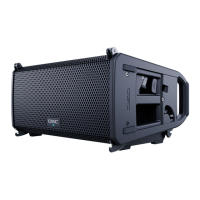14
Understanding Splay Angles
QSC RapidDeploy
™
features a unique Angle Bar with an internal pin mechanism that provides three selectable splay angle adjustments.
These adjustments allow the user to create custom array shapes based on the venue size and application. These three splay angles are:
• 1.5 degrees - This smaller splay angle setting provides
maximum high frequency coupling between adjacent
boxes, delivering the greatest throw:
◦ In a 2-box array this smaller splay angle setting
is ideally suited for large venues or temporary
outdoor applications.
◦ In a taller 3-6 box array, this smaller splay angle setting should always be used at the top of the array, which is typically aimed
towards the rear-most section of the audience.
• 6 degrees - This medium splay angle setting provides less high frequency
coupling between adjacent boxes, delivering a moderate throw:
◦ In a 2-box array this medium splay angle setting is ideally suited for
mid-sized venues.
◦ In a taller 3-6 box array, this medium splay angle setting acts as a
coverage transition and should always be in the center of the array,
which is typically aimed towards the middle section of the audience.
• 12 degrees - This larger splay angle setting provides minimal high frequency coupling
between adjacent boxes, delivering a reduced throw:
◦ In a 2 box array this large splay angle setting is ideally suited for small venues or clubs.
◦ In a taller 3-6 box array, this large splay angle setting should be used at the very bottom
of the array, which is typically aimed towards the front-most section of the audience.
Progressive Splay Angle Rule
A larger splay angle value can NOT be used above a
smaller splay angle value, as this will result in an unsupported
loudspeaker array that cannot be optimized. The splay angle
values must either match or progressively increase in size from
the top of the array to the bottom. Here is an example of a
supported array versus an unsupported array:
NOTE: Although it is technically possible
to deploy and use the array using any splay
angle combination, which does not follow the
Progressive Splay Angle Rule, QSC does not
recommend those deployments.
In such cases, the Ar-Q
™
Array Equalization and
individual loudspeaker EQ can be manually set to
taste. In that process, QSC recommends setting all
line array loudspeakers to a single loudspeaker
voicing because using multiple array equalization
settings may cause undesired acoustic results.
—Figure5—
—Figure6—
—Figure7—
—Figure8—
1.5°
1.5°
6°
6°
12°

